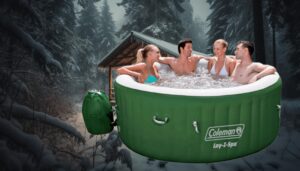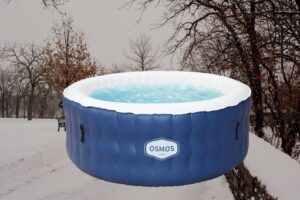An inflatable hot tub is a portable and temporary spa or hot tub that is designed to be filled with air for structure and water for use. Unlike traditional fixed hot tubs or spas, inflatable hot tubs are made of flexible materials, usually durable PVC or vinyl, and can be inflated and deflated as needed. These portable hot tubs have gained popularity for their affordability, ease of setup, and versatility.
How do I choose an inflatable hot tub?
Choosing the right inflatable hot tub is akin to finding the perfect companion—each has its unique features and quirks. Here are some factors to consider:
1. Capacity and Size:
- Determine how many people you want to accommodate.
- Consider the available space in your backyard or patio.
2. Jets and Bubbling Action:
- Assess the number and power of jets for a customized massage experience.
- Look for features like adjustable settings and directional flow.

3. Construction Material:
- Opt for durable materials like PVC or vinyl.
- Check for reinforced construction to prevent leaks and punctures.
4. Heating System:
- Ensure the heating system is efficient and can maintain your desired temperature.
- Look for rapid heating options to minimize wait time.
5. Ease of Setup:
- Choose a model with straightforward assembly instructions.
- Consider inflatable hot tubs with user-friendly control panels.
6. Budget:
- Set a budget range and explore options within that range.
- Factor in long-term costs, including maintenance and energy consumption.
Do inflatable hot tubs get hot enough?
One common concern among prospective hot tub enthusiasts is whether inflatable models can reach and maintain a sufficiently high temperature. Let’s debunk this myth:
Inflatable hot tubs are designed to heat water to temperatures comparable to their traditional counterparts. Most models can reach temperatures between 100°F and 104°F (37.8°C to 40°C), providing a soothing and relaxing experience. The key lies in the efficiency of the heating system, so it’s crucial to choose a reputable brand with a powerful heating element.
To optimize heat retention, consider the following tips:
- Insulation: Look for models with good insulation to keep the water warm for longer periods.
- Cover Usage: Always use the provided cover when the hot tub is not in use to prevent heat loss.
- Location: Place your inflatable hot tub in a sheltered area to shield it from wind, which can contribute to heat dissipation.
Remember, the pleasure of soaking in your inflatable hot tub at the perfect temperature is just a well-designed heating system away.

How do inflatable hot tubs maintain?
The maintenance of an inflatable hot tub is a breeze compared to traditional, fixed installations. Follow these tips to keep your hot tub in top-notch condition:
1. Water Chemistry:
- Regularly test the water’s pH levels and adjust as needed.
- Use water treatment chemicals to prevent algae and bacteria growth.
2. Cleaning:
- Clean the filter regularly and replace it according to the manufacturer’s recommendations.
- Wipe down the interior and exterior surfaces to prevent dirt buildup.
3. Draining and Refilling:
- Drain and refill the hot tub every 2-3 months to maintain water freshness.
- Consider using a submersible pump for faster draining.
4. Storage:
- During winter or extended periods of non-use, deflate and store the hot tub indoors.
- Ensure the storage area is dry and well-ventilated to prevent mold.
5. Cover Care:
- Clean the cover periodically and ensure it’s free of debris.
- Apply a UV protectant to prevent sun damage.
Should I leave my inflatable hot tub on all the time?
The decision to leave your inflatable hot tub on constantly depends on your usage patterns and personal preferences. Here are some considerations:
1. Energy Consumption:
- Leaving the hot tub on continuously will increase energy consumption.
- Consider using a timer to schedule heating cycles during anticipated usage periods.
2. Heating Time:
- If you use your hot tub frequently, keeping it on can reduce the wait time for the water to reach your desired temperature.
- Modern inflatable hot tubs often feature rapid heating options, minimizing the need for constant operation.
3. Cost Considerations:
- Factor in the cost of electricity in your region when deciding whether to keep the hot tub on.
- Some users prefer to turn it off during non-peak usage hours or when not in use for an extended period.
4. Manufacturer’s Recommendations:
- Refer to the manufacturer’s guidelines for optimal usage patterns and energy-saving tips.
- Adhering to these recommendations ensures the longevity of your inflatable hot tub.





